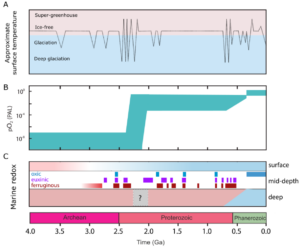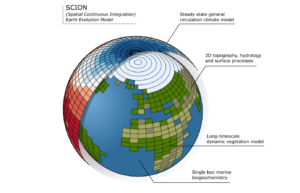Alternative Earths and their habitability for complex life
The list of ‘potentially Earth-like’ rocky exoplanets in the galaxy continues to grow, and recent instrumental advances are paving the way to the analysis of their atmospheric compositions. But which planets should we study in more detail? Are planets larger or smaller than Earth more likely to host complex (e.g. multicellular or eukaryotic) life? Should we be looking around stars larger or smaller than our own Sun? Do planets need to be of a certain age before complex life becomes possible? The answers to these questions hinge on a better understanding of how our own planet has changed over time (e.g. Figure 1), which can be achieved by building a quantitative computer simulation of the broad aspects of the evolution of the planetary surface environment, and comparing its predictions to the known changes on Earth. With such a ‘Planetary System Model’, rather than the more typical ‘Earth System Model’, we can replay the tape of environmental and biotic evolution on Earth, and then re-run this experiment for simulated planets which may be very different to our own.

Figure 1 | Environmental evolution on Earth. A. Surface temperature. B. Atmospheric oxygen levels. C. Marine redox state.
In this project, the student will build on world-leading research into long-term Earth surface evolution, expanding our current computer models for the long-term development of the key tectonic, biotic and chemical cycles (e.g. Alcott et al. 2019; Krause et al., 2022; Rushby et al., 2018) to include a broader suite of metabolisms and processes (e.g. Zhao et al., 2023) that will allow us to simulate the overall habitability of a planet for Earth-like complex life (e.g. high O2, low H2S, tolerable temperatures, pH, salinity). It will be possible to write this new model from scratch in whatever programming language the student prefers, or to begin from one of our already-published models written in python or MATLAB (e.g. see https://github.com/bjwmills ). No specific background knowledge is required and we aim to provide bespoke training in the required skills. We will first test the model framework by comparing its reconstruction of Earth’s surface conditions to multiple lines of geological and geochemical evidence, and we expect to publish high quality work (e.g. in the same high impact journals as our work above) both on the evolution of the Earth and on the application of the model to hypothetical and real exoplanet environments.

Figure 2 |Example of current models. The current SCION Earth Evolution model may form a basis for this work.
Working environment
The research will be based in Mills’ Earth Evolution Modelling Group, which is part of the Earth Surface Science Institute (ESSI), within the School of Earth and Environment at the University of Leeds. ESSI is a medium sized and friendly research institute that includes analytical geochemists, biogeochemists, sedimentologists, palaeontologists and modellers of climate and biogeochemistry. The group holds several annual science and social events and weekly informal get-togethers. Project supervisor Mills has received multiple ESSI ‘Star Supervisor’ awards.
Entry requirements
This project would suit somebody with a degree in one of the natural sciences, mathematics or computing, and the candidate should have a strong interest in Earth history and planetary surface environments. Formal training in numerical techniques is not essential, but enthusiasm for computing is advisable. All necessary training will be provided as part of the project.
Further information
Professor Mills can be reached at b.mills@leeds.ac.uk for any questions about this project. See https://bjwmills.com for more information about the Earth Evolution Modelling Group.
References cited
Alcott, L. J., Mills, B. J. W. & Poulton, S. W. Stepwise Earth oxygenation is an inherent property of global biogeochemical cycling. Science 366, 1333-1337 (2019).
Krause, A., Mills, B., Merdith, A., Lenton, T. & Poulton, S. Extreme variability in atmospheric oxygen levels in the late Precambrian. Science Advances 8, eabm8191 (2022).
Rushby, A. J., Johnson, M., Mills, B. J. W., Watson, A. J. & Claire, M. W. Long-Term Planetary Habitability and the Carbonate-Silicate Cycle. Astrobiology 18, 469-480 (2018).
Zhao, M., Mills, B. J. W., Homoky, W. B. & Peacock, C. L. Oxygenation of the Earth aided by mineral–organic carbon preservation. Nature Geoscience (2023).
